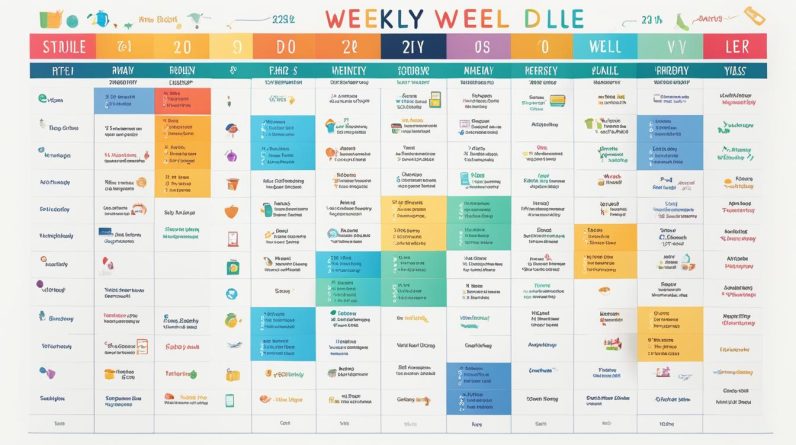Trying to balance full-time work and homeschooling can be overwhelming, but with the right strategies and time management techniques, it is possible to create a harmonious routine that meets both your professional and educational goals. In this article, we will explore tips and tricks to help you successfully navigate the challenges of working full time while homeschooling your children from home.
Key Takeaways:
- Establish a schedule that incorporates dedicated time for both homeschooling and work tasks.
- Get organized by creating systems and routines that work around your schedule and family needs.
- Delegate responsibilities to other family members or seek support from external resources.
- Embrace flexibility and think outside the box when it comes to scheduling and curriculum.
- Take care of yourself and prioritize self-care to maintain balance and overall well-being.
Tips for Getting Organized
One of the key factors in successfully homeschooling while working full time is getting organized. Creating systems and routines that work around your schedule and family needs is crucial. By implementing these organizational strategies, you can create a smoother workflow and better balance between work and homeschooling.
Consolidating Extracurricular Activities
When it comes to time management for homeschooling, it’s important to consolidate extracurricular activities. While it’s essential for children to engage in activities outside of homeschooling, it’s also important to be mindful of how these activities fit into your schedule. Evaluate which activities are most valuable and prioritize them accordingly. This way, you can ensure that your children still have enriching experiences without overwhelming your time and energy.
Involving Children in Housework and Cooking
One way to manage your time effectively is by involving your children in housework and cooking. Assign age-appropriate tasks to your children that contribute to the household chores. Not only does this lighten your responsibilities, but it also teaches your children valuable life skills. By working together as a family, you can maintain a clean and organized environment while also fostering a sense of responsibility in your children.
Establishing a Regular Schedule for Academic Progress
A regular schedule for checking in on your children’s academic progress is essential for effective homeschooling. Set aside specific times throughout the week to review your children’s work, discuss their learning goals, and provide feedback. This dedicated time allows you to ensure that your children are staying on track academically and address any areas that may need additional attention. By establishing a routine for academic progress, you can maintain a productive homeschooling environment.
“Organizing and planning ahead can make all the difference in successfully balancing work and homeschooling. Take the time to evaluate your schedule, involve your children in household tasks, and establish a routine for checking in on their academic progress. These strategies will help you create a well-organized and balanced life that allows for both work and homeschooling.”
Getting organized is a fundamental step in achieving a harmonious balance between work and homeschooling. By consolidating extracurricular activities, involving children in housework and cooking, and establishing a regular schedule for checking in on academic progress, you can streamline your daily routine and create a better equilibrium. Stay tuned for more tips on how to successfully manage work and homeschooling simultaneously.
Maximizing Productivity with Time Allocation
When you are homeschooling while balancing full-time work, efficient time management becomes crucial. Allocating your time effectively allows you to maximize productivity and focus on both your work and homeschooling responsibilities. By following a structured schedule and setting aside dedicated time for each task, you can ensure that you give adequate attention to both areas of your life.
To make the most of your time, it’s essential to prioritize your tasks. Determine the most important and urgent responsibilities for both work and homeschooling. By establishing clear priorities, you can allocate the appropriate amount of time and energy to each one.
To create a well-balanced schedule, consider using time blocks. Set specific time periods for homeschooling, work-related activities, and household chores. This way, you can focus on one area at a time, giving your full attention to the task at hand.
Here’s an example of how you can allocate your time throughout the day:
| Time | Activity |
|---|---|
| 8:00 AM – 9:00 AM | Homeschooling (Math) |
| 9:00 AM – 11:00 AM | Work-related tasks |
| 11:00 AM – 12:00 PM | Homeschooling (Science) |
| 12:00 PM – 1:00 PM | Lunch and break time |
| 1:00 PM – 3:00 PM | Work-related tasks |
| 3:00 PM – 4:00 PM | Homeschooling (English) |
| 4:00 PM – 5:00 PM | Household chores |

Adhering to a consistent schedule helps create a sense of structure and stability. It also enables you to maintain a healthy work-life balance, ensuring that you have time for your family, self-care, and relaxation.
Remember, effective time allocation is key to successfully managing the demands of both work and homeschooling. By prioritizing tasks and setting aside dedicated time, you can maximize your productivity and create a harmonious balance in your daily life.
Sharing Responsibilities and Delegating
As a working parent homeschooling your children, finding a balance between work and homeschooling can seem overwhelming. However, sharing responsibilities and delegating tasks can make a significant difference in managing your workload and creating harmony within your household.
“Alone we can do so little; together we can do so much.” – Helen Keller
Involving other family members, such as your spouse or older children, in the teaching process can alleviate some of the pressure. By delegating certain responsibilities, everyone can contribute to the success of your children’s education and ensure a more balanced dynamic at home.
Consider the following strategies to share responsibilities and delegate tasks:
- Have your spouse or partner take charge of specific subjects or lessons. For example, if one of you excels in mathematics, let them handle the math curriculum.
- Assign older children to assist with younger sibling’s learning activities or help with grading assignments.
- Rotate household chores and responsibilities among family members to ensure everyone contributes to the household’s smooth functioning.
- Utilize the support of extended family members, such as grandparents, who can offer assistance with homeschooling tasks.
Remember, seeking outside support can also be beneficial in managing your workload. Consider hiring a babysitter or tutor to provide assistance with homeschooling, allowing you to focus on your work responsibilities.
Additionally, connecting with other homeschooling families can facilitate resource sharing and provide opportunities for co-teaching or group activities. Online platforms, local homeschooling networks, and community organizations can offer valuable support and advice.
Benefits of Sharing Responsibilities and Delegating
Sharing responsibilities and delegating tasks not only lightens your workload but also cultivates a sense of ownership and shared accomplishment within your family. By involving other family members, you create a collaborative learning environment that fosters communication, cooperation, and mutual support.
Delegating tasks also allows your children to learn valuable life skills, such as responsibility, time management, and collaboration. Taking on age-appropriate tasks can contribute to their personal development and empower them to take an active role in their education.
| Benefits of Sharing Responsibilities and Delegating | Benefits of Sharing Responsibilities and Delegating |
|---|---|
| Lightens your workload, reducing stress and overwhelm. | Cultivates a sense of ownership and shared responsibility within the family. |
| Encourages collaboration, communication, and mutual support among family members. | Empowers children to develop important life skills, such as responsibility and time management. |
| Allows you to focus on your work responsibilities while ensuring your children receive quality education. | Provides opportunities for children to learn from and support each other’s academic growth. |

Creating a shared commitment to both work and homeschooling can lead to a more harmonious and balanced lifestyle for you and your family. Embracing the support of loved ones and seeking outside assistance when needed can make the juggling act of work and homeschooling more manageable.
Flexibility and Outside-the-Box Thinking
Homeschooling allows for flexibility and outside-the-box thinking when it comes to scheduling and curriculum. One of the benefits of homeschooling is the ability to tailor your child’s education to their individual needs and interests. This includes finding creative ways to accommodate your work commitments while ensuring your child receives a quality education.
Instead of adhering strictly to a traditional school year and weekly schedule, consider adjusting the academic calendar to align with your work schedule. This may involve extending the school year into the summer months or implementing shorter, more focused learning periods during the week.
To make the most of your work from home and homeschooling arrangement, take advantage of weekends, school holidays, and vacations to continue educational activities. These dedicated times can provide opportunities for hands-on learning experiences, field trips, and exploration of subjects beyond the scope of traditional curriculum.
Another way to foster flexibility in homeschooling is by adopting a more personalized approach to curriculum. While there are numerous homeschooling curricula available, you have the freedom to choose or create a customized curriculum that aligns with your child’s learning style, strengths, and interests. Incorporate real-world applications, interactive activities, and field experiences to engage your child and enhance their learning experience.

Benefits of Flexibility and Outside-the-Box Thinking in Homeschooling:
| Benefits | Explanation |
|---|---|
| Customization | Adapt curriculum based on your child’s needs and interests. |
| Time management | Align homeschooling schedule with work commitments. |
| Engagement | Incorporate hands-on activities and real-world applications. |
| Exploration | Utilize weekends, holidays, and vacations for in-depth learning experiences. |
By embracing a more flexible approach to homeschooling, you can create an engaging and adaptable learning environment that meets both your work and educational goals. Remember to regularly assess and adjust your schedule and curriculum as needed to ensure a successful balance between work and homeschooling responsibilities.
Incorporating Work into Homeschooling
Integrating work-related lessons into the homeschooling curriculum can be a valuable way to engage your children and connect their learning to real-life experiences. By intertwining work and homeschooling, you can create a cohesive and meaningful educational experience for your children.
One way to incorporate work into homeschooling is by involving your children in work tasks. For example, you can teach them about business and responsibility by having them assist with administrative work, such as labeling catalogs or organizing files. This hands-on experience allows them to apply their academic knowledge in a practical setting, fostering a deeper understanding of the concepts they are learning.
Another approach is to explore work-related resources and materials that align with your homeschooling curriculum. Look for educational resources that offer insights into various professions, industries, or entrepreneurial ventures. These resources can include books, online courses, documentaries, or virtual field trips. By incorporating these materials into your lessons, you can expose your children to different career paths and help them develop a well-rounded understanding of the working world.

| Benefits of Incorporating Work into Homeschooling |
|---|
| 1. Real-world application of academic concepts |
| 2. Development of practical skills |
| 3. Exposure to different career paths |
| 4. Reinforcement of discipline and responsibility |
| 5. Promotion of critical thinking and problem-solving |
By incorporating work-related lessons into your homeschooling curriculum, you can provide your children with a well-rounded education that prepares them for the future. It allows them to apply their knowledge in practical ways, develop essential skills, and gain insights into potential career paths. Remember to tailor the approach to your children’s interests and abilities, making the experience both educational and enjoyable.
Taking Advantage of Flexible Work Schedules
If your job allows for flexibility, you have a valuable opportunity to find a perfect balance between work and homeschooling. Working from home can provide the freedom to schedule school hours around your work commitments. By effectively managing your time, you can create a harmonious routine that meets both your professional and educational goals.
Here are a few tips for taking advantage of flexible work schedules:
- Create a dedicated workspace: Set up a designated area in your home where you can focus on your work tasks. This will help you separate work from homeschooling and maintain a productive mindset.
- Establish clear boundaries: Communicate with your employer, colleagues, and family members about your work schedule and availability. Set specific hours for homeschooling and work-related tasks to ensure that both receive the attention they deserve.
- Utilize remote work options: If your job allows it, take advantage of remote work opportunities. This can provide you with more flexibility in managing your time and allow for a seamless integration of work and homeschooling.
- Plan ahead: Create a weekly schedule that outlines your work hours, homeschooling activities, and other commitments. By planning in advance, you can ensure that all important tasks are included and avoid any last-minute conflicts.
- Stay organized: Use productivity tools or apps to manage your tasks, deadlines, and appointments. Keeping a clear overview of your responsibilities will help you stay on track and minimize stress.
Taking advantage of flexible work schedules not only allows you to handle your professional responsibilities but also provides the opportunity to actively participate in your children’s education.
Real-Life Example: Sarah’s Story
“As a freelance graphic designer, I have the privilege of working from home. This flexibility has been a game-changer for our homeschooling journey. I schedule my work hours early in the morning and during my children’s nap time. This leaves the rest of the day free for hands-on learning experiences and one-on-one instruction. I’m grateful that my job allows me to be actively involved in my children’s education while still pursuing my career.”
Remember, finding a balance between work and homeschooling requires careful planning, effective time management, and open communication with your employer and family. With the right strategies in place, you can create a fulfilling and successful experience for both you and your children.
Creating a Supportive Network
When it comes to balancing work from home and homeschooling, having a supportive network can make all the difference. Building connections with other homeschooling communities, both online and offline, can provide you with valuable resources, guidance, and support throughout your journey.
Online Communities
Online homeschooling groups and forums offer a wealth of advice, tips, and inspiration from experienced homeschoolers. These communities provide a platform for connecting with like-minded parents, exchanging ideas, and seeking support. Whether you’re looking for curriculum recommendations, time management strategies, or simply a place to vent and share your experiences, online communities offer a welcoming space for all.
Joining online homeschooling communities can give you access to a wealth of knowledge and support from experienced homeschooling parents. It’s like having a virtual village cheering you on!
Local Homeschooling Groups
Aside from online resources, local homeschooling groups can provide you with unique opportunities to connect with other homeschooling families in your area. These groups often organize workshops, classes, field trips, and social events that allow for meaningful interactions and collaborations. By joining a local homeschooling group, you can build friendships, share ideas, and create lasting memories with other families who are on a similar homeschooling journey.
| Benefits of Joining a Supportive Network: |
|---|
| Access to valuable resources and information |
| Opportunities for collaboration and joint learning |
| Emotional support and encouragement |
| Shared experiences and the sense of community |
By actively participating in both online and local homeschooling communities, you can gain the support and guidance you need to successfully balance work from home and homeschooling. Remember, you’re not alone in this journey!
Simplifying and Streamlining Your Approach
When it comes to homeschooling while juggling work responsibilities, simplifying and streamlining your approach can make a significant difference. By implementing strategies and tools that help reduce stress and increase efficiency, you can create a more manageable homeschooling experience that balances work and education seamlessly.
Utilize an Adaptable Homeschooling Curriculum
One effective way to simplify your homeschooling approach is to utilize a curriculum that can easily adapt to multiple grade levels or accommodate switching between grades. Look for homeschooling resources that offer flexibility and provide comprehensive lesson plans that align with your children’s educational needs. This way, you can streamline your planning process and save time by utilizing a curriculum that meets the needs of all your children simultaneously.
Stay Organized with Planning Tools and Resources
Staying organized is key to efficiently managing both work and homeschooling. Consider utilizing planning tools and resources to help you maintain a clear and structured schedule. Online planners, homeschooling apps, or printable calendars can assist in keeping track of assignments, activities, and important milestones. By staying organized, you can better allocate your time and ensure that both work and homeschooling tasks are completed effectively.
Implement Time-Saving Strategies
When balancing work and homeschooling, time management is crucial. Identify areas where you can save time while maintaining educational productivity. For example, consider incorporating multi-purpose activities that integrate different subjects into a single lesson. Additionally, explore online homeschooling platforms or programs that offer pre-designed lesson plans, quizzes, and assessments, providing you with more time to focus on other priorities.
Take Advantage of Supportive Communities
Building a network of like-minded homeschooling families can provide valuable support and resources. Connect with other homeschoolers through local meetups, online forums, or social media groups. By sharing tips, experiences, and resources, you can streamline your approach and benefit from the collective wisdom of the homeschooling community. Don’t shy away from asking for help or advice when needed, as the homeschooling community is often eager to support one another.
| Homeschooling Curriculum | Homeschooling Resources | Work and Homeschooling Balance |
|---|---|---|
| Easily adaptable for multiple grade levels | Connect with supportive homeschooling communities | Utilize time-saving strategies and tools |
| Provides comprehensive lesson plans | Access to online forums and social media groups | Implement efficient planning and organization |
| Caters to individual learning styles | Share tips and resources with other homeschoolers | Find ways to save time and maximize productivity |
Embracing the Challenges and Chaos
Homeschooling while working full time undoubtedly comes with its challenges and chaotic moments. But don’t let that discourage you. Embrace these challenges and find humor in the chaos, because, in the end, it’s all part of the experience.
There will be days when things don’t go according to plan, and that’s okay. Accept that some days may be harder than others, and it’s alright to take a step back and regroup. Remember, you’re doing your best in juggling both work and homeschooling responsibilities.
Flexibility is key in managing the ups and downs of homeschooling and working simultaneously. Embrace the unexpected and adapt your schedule as needed. Being open to change will help you navigate through the challenges more smoothly.
It’s important to maintain a positive outlook throughout your homeschooling journey. Your attitude and mindset can greatly impact the overall experience for both you and your children. Find joy in the process and celebrate the small wins along the way.
“The greatest glory in living lies not in never falling, but in rising every time we fall.” – Nelson Mandela
Remember, the journey of homeschooling while working full time is a unique one. Each day may bring its own set of challenges, but with perseverance and a positive mindset, you can overcome them.
Embrace the challenges, find humor in the chaos, and continue to give your best effort in both homeschooling and work.
Balancing Work and Homeschooling Tips
| Tips | Description |
|---|---|
| 1. Establish a flexible schedule | Create a schedule that allows for both work and homeschooling, taking into account your family’s unique needs. |
| 2. Involve your children | Include your children in the planning process and delegate age-appropriate responsibilities to lighten your workload. |
| 3. Find support | Join homeschooling communities and connect with other working parents to share tips, resources, and experiences. |
| 4. Embrace flexibility | Be open to adjusting your schedule and homeschooling approach when needed, allowing for unexpected changes or challenges. |
| 5. Take breaks and practice self-care | Remember to prioritize self-care and take breaks to recharge, ensuring your overall well-being. |
Practicing Self-Care and Finding Balance
Amidst the busyness of homeschooling and work, it’s crucial to prioritize self-care and find balance. Taking care of yourself allows you to better care for your children and fulfill your professional responsibilities. Balancing work, homeschooling, and personal well-being is key to maintaining overall happiness and success.
Here are some homeschooling tips and strategies for time management that can help you find the equilibrium you need:
- Schedule regular breaks: Carve out time in your day to engage in activities that rejuvenate you. Whether it’s going for a walk, meditating, reading a book, or pursuing a hobby, these breaks will refresh your mind and provide a well-deserved pause from your responsibilities.
- Create boundaries: Establish clear boundaries between work and personal life. Set specific work hours and designate separate areas for work and relaxation. This way, you can fully focus on each aspect without feeling overwhelmed or constantly multitasking.
- Delegate tasks: Don’t be afraid to ask for help. Delegate household chores, responsibilities, and some aspects of homeschooling to your spouse, older children, or other family members. This will alleviate the pressure on you and provide the opportunity for everyone to contribute.
- Practice self-reflection: Regularly check in with yourself to assess your well-being. Reflect on your emotions, stress levels, and overall satisfaction. If you notice any signs of burnout or excessive stress, take proactive steps to address them, such as seeking support from a therapist or engaging in self-care activities.
- Set realistic expectations: It’s essential to acknowledge that you can’t do it all perfectly. Don’t strive for perfection, but instead aim for balance and progress. Understand that some days will be more challenging than others, and that’s okay. Focus on doing your best and adjusting as needed.
Remember, taking care of yourself is not selfish but necessary. By prioritizing self-care and finding balance, you will cultivate a healthier and more fulfilling homeschooling and work experience.
| Benefits of Self-Care and Balance | Strategies to Achieve Self-Care and Balance |
|---|---|
| 1. Reduced stress levels | 1. Schedule regular breaks |
| 2. Increased focus and productivity | 2. Create boundaries between work and personal life |
| 3. Improved overall well-being | 3. Delegate tasks |
| 4. Enhanced relationships with children and spouse | 4. Practice self-reflection |
| 5. Better physical and mental health | 5. Set realistic expectations |
Adjusting and Adapting
When it comes to balancing work and homeschooling, it’s important to recognize that finding the perfect balance is an ongoing process of adjustment and adaptation. You may encounter challenges along the way, but by staying open-minded and flexible, you can successfully navigate this unique situation.
Be patient with yourself and your children as you navigate this new territory. Remember, homeschooling and working simultaneously can be challenging, but with time and practice, you will find a rhythm that works for your family.
Stay open to making changes to your schedule or approach as needed. Flexibility is a valuable skill in managing the demands of work and homeschooling. What works well one week may need adjustments in the following weeks, and that’s okay. Embrace the opportunity to adapt and find what works best for you and your family.
By remaining flexible and adaptable, you will be better equipped to handle the demands of work and homeschooling in the long run. Embrace the journey, be patient, and remember that with time, practice, and adjustments, you can find a harmonious balance between your professional and educational duties.
FAQ
Can I successfully homeschool my children while working full time?
Yes, it is possible to balance full-time work with homeschooling. With proper planning, organization, and support, you can manage both responsibilities effectively.
How can I get organized to handle work and homeschooling?
Creating systems and routines that work around your schedule and family needs is crucial. Consolidating extracurricular activities, involving children in housework and cooking, and establishing a regular schedule for checking academic progress can help manage the workload.
How can I allocate my time efficiently between work and homeschooling?
Prioritize tasks and set aside dedicated time for both homeschooling and work. Establish time blocks for specific activities, and adhere to a consistent schedule to ensure each responsibility receives adequate attention.
How can I share responsibilities and delegate tasks?
Involving other family members, such as your spouse or older children, in the teaching process can help lighten your workload. Additionally, seeking support from babysitters, tutors, and other homeschooling families can provide valuable assistance and relief.
How can I make homeschooling more flexible to accommodate my work commitments?
Consider rethinking the traditional school year and weekly schedule. Take advantage of weekends, summertime, and vacations for continued educational activities. Embrace a flexible approach to homeschooling to adapt the curriculum to fit your family’s needs and maximize learning opportunities.
How can I integrate work-related lessons into the homeschooling curriculum?
Involve your children in work tasks, such as labeling catalogs or assisting with administrative work, to teach them about business and responsibility. By intertwining work and homeschooling, you can create a cohesive and meaningful educational experience.
Can remote work options or part-time schedules help balance work and homeschooling?
If feasible, taking advantage of remote work options or part-time schedules can provide opportunities for more integrated homeschooling. Scheduling school hours around work commitments can help create a harmonious routine that meets both professional and educational goals.
How can I find support while homeschooling and working full time?
Building a supportive network of homeschooling communities, both online and local, can offer valuable resources and support. Online groups and forums can provide advice and inspiration, while local homeschooling groups can offer workshops, classes, field trips, and connections with other homeschooling families.
How can I simplify and streamline my homeschooling approach?
Utilize a curriculum that can be easily adapted for multiple grade levels or switched between grades. Use planning tools and resources to stay organized and focused. Finding ways to simplify and streamline can make homeschooling more manageable.
How can I maintain a positive outlook amidst the challenges of work and homeschooling?
Embrace the challenges and find humor in the chaos. Accept that there will be off days and that’s okay. Flexibility and a positive outlook can help navigate the ups and downs of homeschooling and working simultaneously.
How can I prioritize self-care while balancing work and homeschooling?
Take time for yourself, whether it’s going for a walk, reading a book, or pursuing a hobby. Remember that taking care of yourself allows you to better care for your children and fulfill your professional responsibilities. Balancing work, homeschooling, and personal well-being is key to maintaining overall happiness and success.
How can I adjust and adapt to the demands of work and homeschooling?
Recognize that finding the perfect balance is an ongoing process. Be patient with yourself and your children as you navigate this unique situation. Be open to making changes to your schedule or approach as needed and remember that flexibility is a valuable skill.






